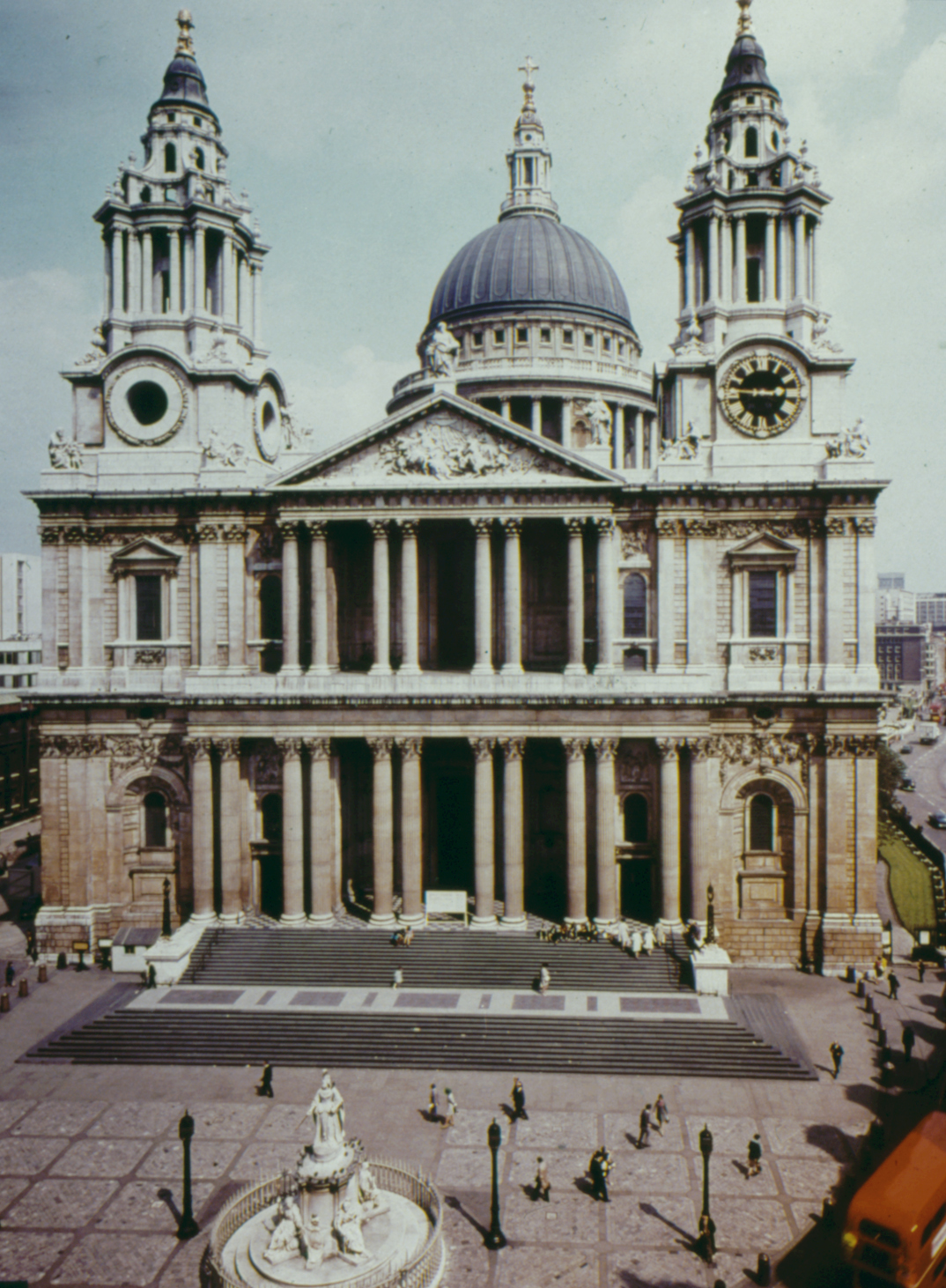

I was very grateful for the invaluable assistance given by Robert Crayford. His position of Assistant Surveyor and assistant to the Librarian at that time, not only made him a useful guide but enabled him to uncover the facts relating to the unusual nature of the Langley Bradley clock. Mervyn Hobden also helped when it come to looking in detail at the clocks that were installed there.
St. Paul's Cathedral was built on the highest point within the City of London, Ludgate Hill. (The second highest hill has the Tower of London on it.) St.Pauls did not just function as a church, it was also a meeting place, a market place, (and upmarket shopping mall), a community centre, etc. and a reference point which could be seen for miles. It was visible from Walthamstow village some 4 miles away "as the crow flies" so would have been seen from the grammar school that I went to which had been founded in 1512. Much of the original Tudor buildings around then still remained, from which the 16th century girls and boys, teachers, parents, local shop keepers, pensioners in the alms houses, and workers tidying the spooky graves around the church, would have seen, on a clear day, not the dome we see today, but a steeple.
In 1344 "Walter the Clockmaker of Southwark" was employed by the Dean and Chapter to install an elaborate dial and gearing to turn an angel surmounting the clock. For this he was paid £ 6 and all the old clockworks no longer of use to the Dean and Chapter (but very useful to a clockmaker).
At that time the separate bell tower, was not on top as part of the steeple, or in the Cathedral building but in the front. It contained four bells and was surmounted by a spire topped with a statue of St. Paul.
By the 16th century, the building was looking neglected. When King Henry VIII was playing a game of dice, with his friend Sir Miles Partridge, (Partridge's sister-in-law was nurse to Henry VIII's bastard son, Henry Fitzroy). Henry VIII offered the bell tower at St. Pauls against Partridge's wager of £100. Partridge won. He now owned the bell tower, with its valuable metal bells. He had the bell tower demolished statue and all. The bells were broken up for scrap. They were valued at £600. This did not made him popular in the city.
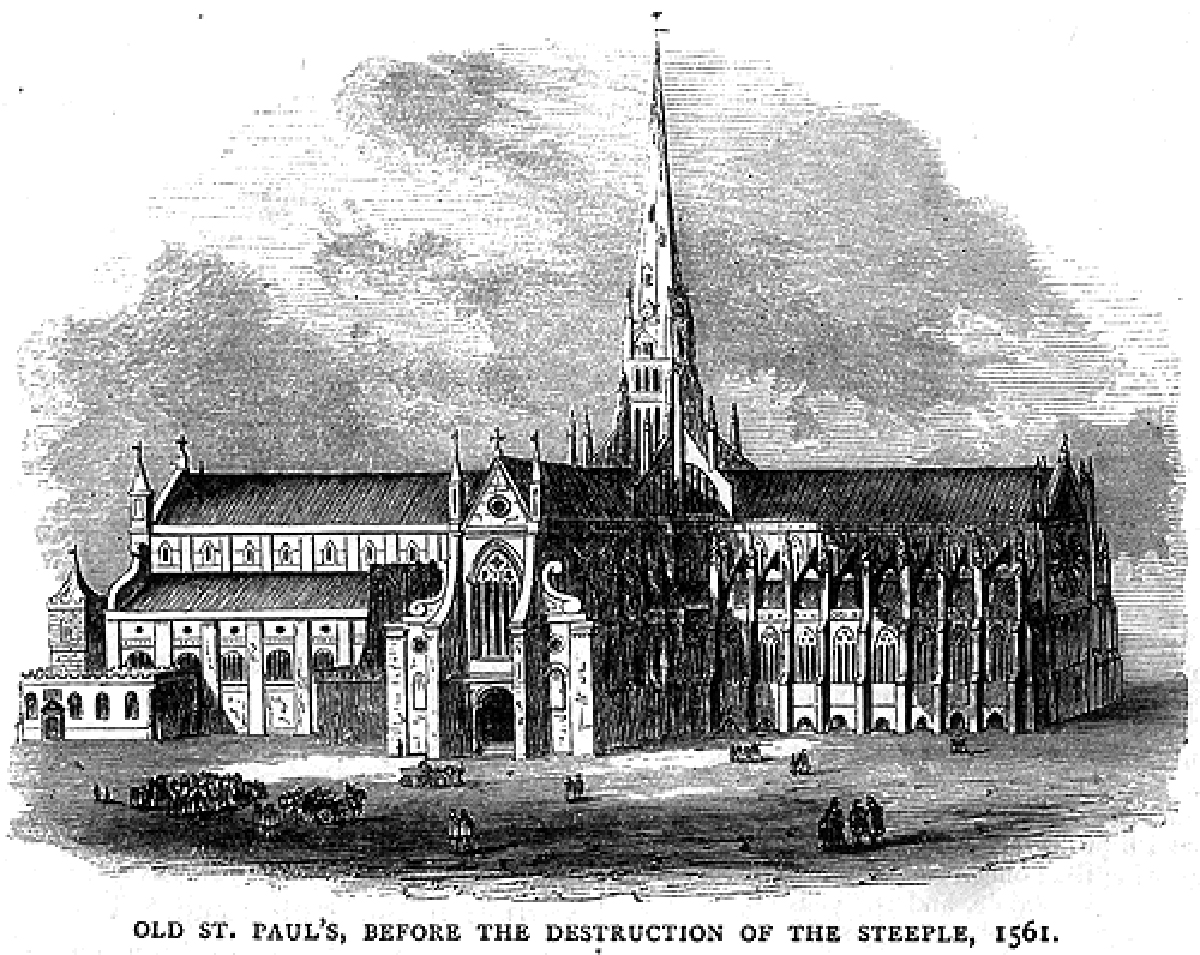 Aristocratic vandalism continued to affect St. Pauls later in the 16th century. In 1549, the Duke of Somerset, uncle of Henry VIII's surviving son, now the schoolboy king Edward VI, helped himself to the stone walls of the cloisters of St.Paul's, to use the materials to contribute to the building of his new palace of Somerset House. Somerset was unpopular as he had established himself as "Lord Protector", as well as vandalizing public buildings and taking them over, for his own profit and use. This did nothing to assist his waning popularity, the young King also hated him, and he was overthrown from his position as Lord Protector. In 1552, after an attempted but failed coup, both the Duke of Somerset and Sir Miles Partridge were executed on Tower Hill (the other prominent hill in the City of London).
Aristocratic vandalism continued to affect St. Pauls later in the 16th century. In 1549, the Duke of Somerset, uncle of Henry VIII's surviving son, now the schoolboy king Edward VI, helped himself to the stone walls of the cloisters of St.Paul's, to use the materials to contribute to the building of his new palace of Somerset House. Somerset was unpopular as he had established himself as "Lord Protector", as well as vandalizing public buildings and taking them over, for his own profit and use. This did nothing to assist his waning popularity, the young King also hated him, and he was overthrown from his position as Lord Protector. In 1552, after an attempted but failed coup, both the Duke of Somerset and Sir Miles Partridge were executed on Tower Hill (the other prominent hill in the City of London).
The citizens of London installed a new bell in the steeple of St. Paul's to replace the ones taken by Partridge. They lost their useful timekeeper, yet again, when in 1561, the steeple was struck by lighting and destroyed. It was never rebuilt as the Bishop of London absconded with the funds that had been collected by the people.
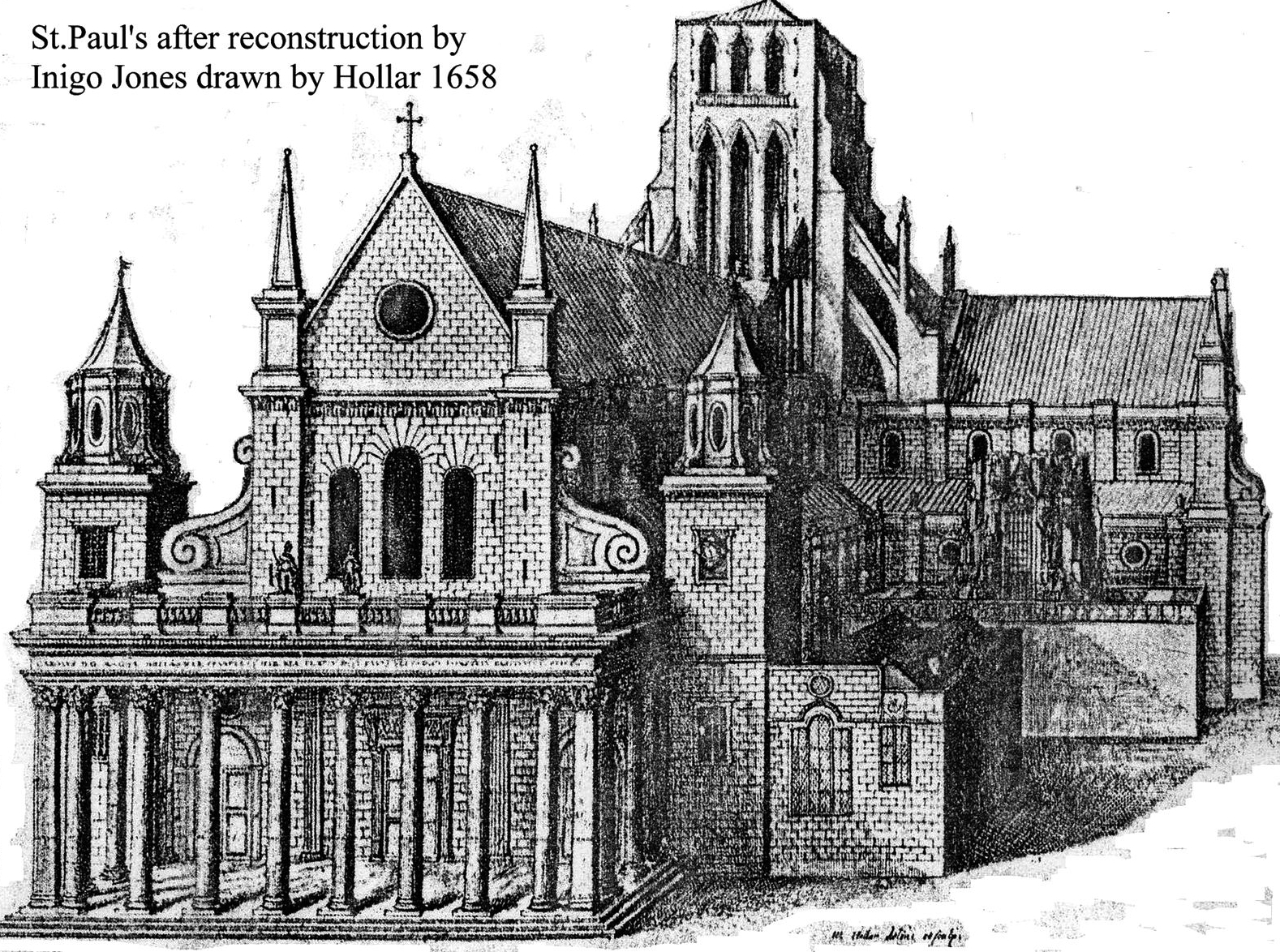 By the 17th century, the Cathedral was in a dilapidated condition. The famous modern architect, Inigo Jones, was employed to restore the appearance of the Cathedral. He rebuilt the West Front in the then trendy, classical style, with a new clock in the south tower.
By the 17th century, the Cathedral was in a dilapidated condition. The famous modern architect, Inigo Jones, was employed to restore the appearance of the Cathedral. He rebuilt the West Front in the then trendy, classical style, with a new clock in the south tower.
During the Civil War, horses were stabled in the Cathedral. It was in a strategic position and become even more damaged. When the battles were over, the astronomer and architect Christopher Wren was approached to make preliminary plans to restore and update the Cathedral.
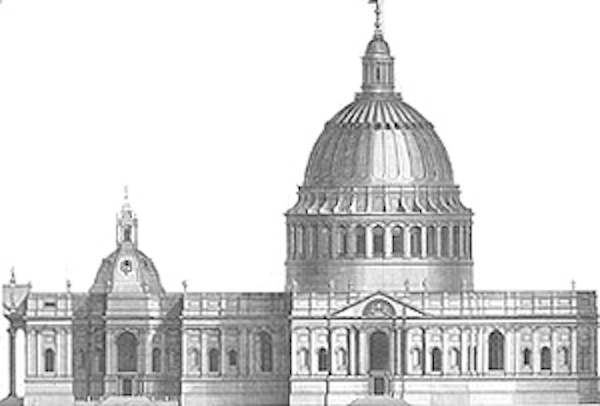 Wren's design inspired by Roman temples, of a big dome and colonades of columns was not accepted. Wren's design inspired by Roman temples, of a big dome and colonades of columns was not accepted. | 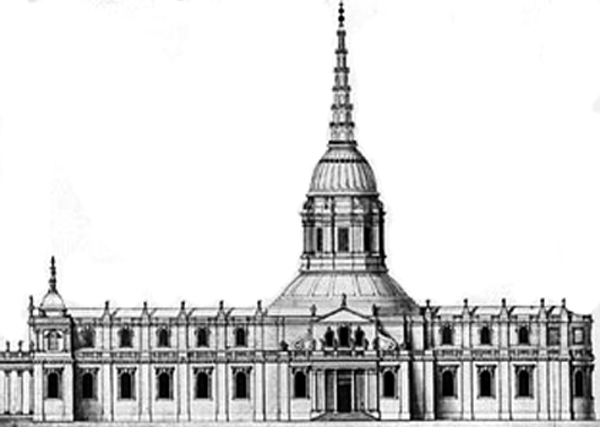 A new steeple was wanted. Wren then submitted a sort of compromise. A sort of thin steeple-like dome. A new steeple was wanted. Wren then submitted a sort of compromise. A sort of thin steeple-like dome. |
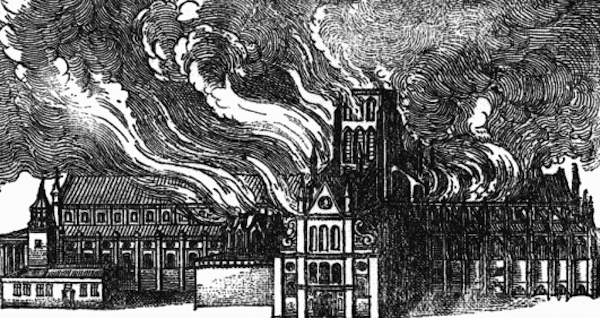 In 1666, the Cathedral was burnt down in the Great Fire of London. The picture on the right shows what was left. This was demolished and cleared, and a competition held to find an architect with an acceptable design for London's new Cathedral. With most of London's older buildings destroyed, and nothing left of the old St. Pauls to work with, Wren's original modern take on the classical Roman style was accepted. In 1666, the Cathedral was burnt down in the Great Fire of London. The picture on the right shows what was left. This was demolished and cleared, and a competition held to find an architect with an acceptable design for London's new Cathedral. With most of London's older buildings destroyed, and nothing left of the old St. Pauls to work with, Wren's original modern take on the classical Roman style was accepted. | 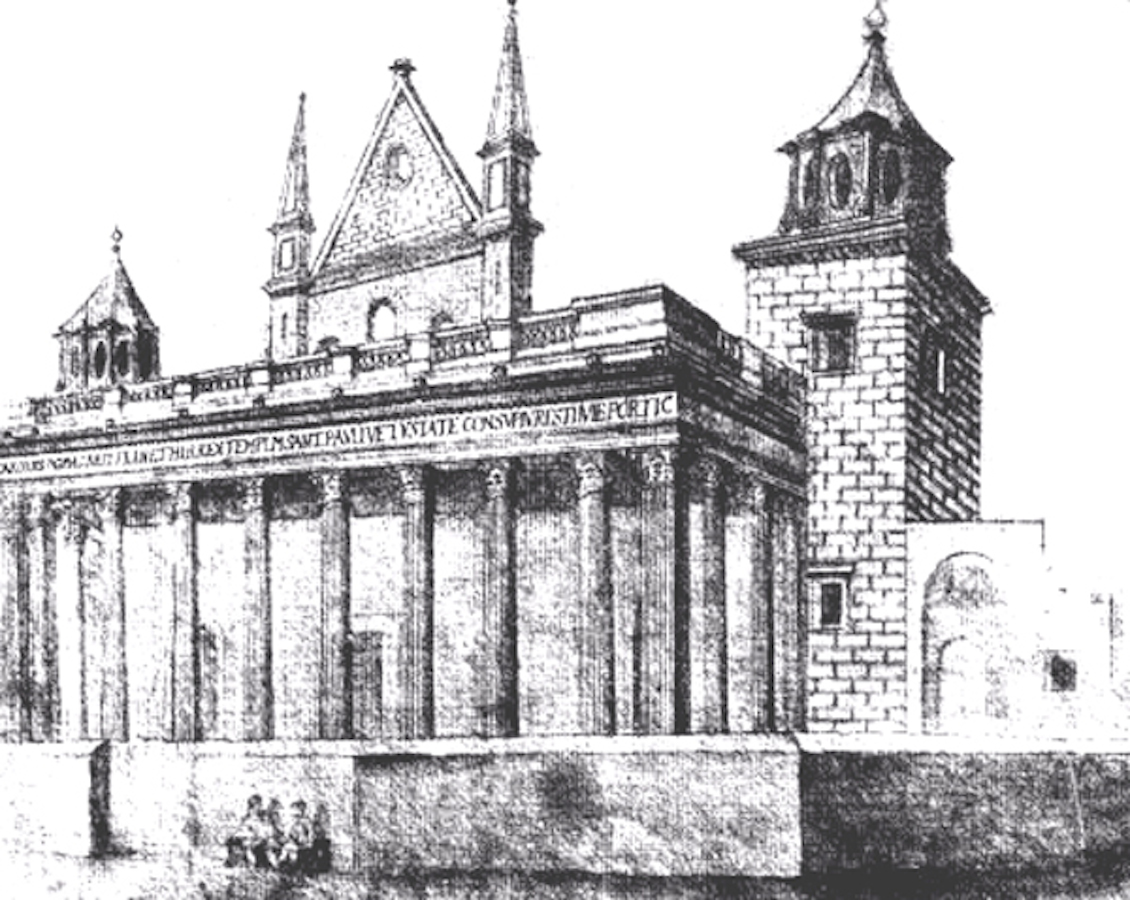 |
Wren was employed as the Surveyor, to design the new cathedral and oversee its construction. In the next few years, not only St. Paul's but all the other churches and the houses, hospitals, schools etc. in the city were being rebuilt after the damage caused by the fire. Being struck by falling masonry when walking through the narrow streets was as much a hazard as being drenched by the contents of a chamber pot emptied out of a window.
It was not until 1706, 30 years after the Great Fire, that the new St. Paul's Cathedral was sufficiently completed to consider the finishing touches. The West Front, was now ready for the installation of a clock. Wren had designed the colonaded portico, now repaired after World War II, so we can see this today. It has formed a familar background to grand and royal occasions, such as Royal weddings and State funerals.
.jpg) In 1706 the building still needed a clock. Either tower could be used as a clock and belfry. Wren had left big holes both sides for a potential clock face. In fact there is still no clock face, the clock you see today, is just the hands pointing to the numbers round the outside rim, and protected only by some netting to keep off birds. It is a bit scary standing there looking out at the fantastic view. (The picture was taken in 1978, view is a lot different now!"). In 1706 the building still needed a clock. Either tower could be used as a clock and belfry. Wren had left big holes both sides for a potential clock face. In fact there is still no clock face, the clock you see today, is just the hands pointing to the numbers round the outside rim, and protected only by some netting to keep off birds. It is a bit scary standing there looking out at the fantastic view. (The picture was taken in 1978, view is a lot different now!"). | 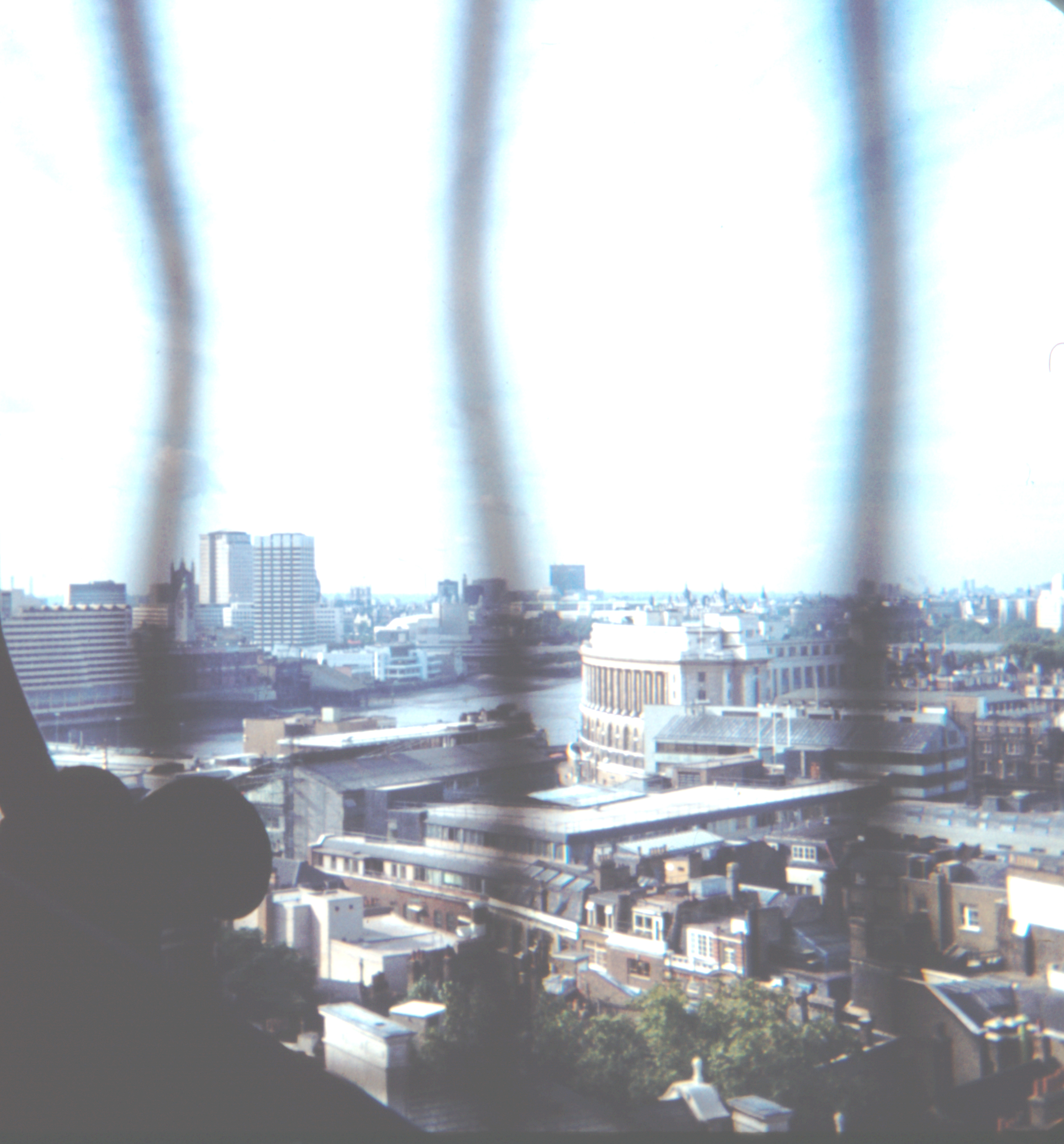 |
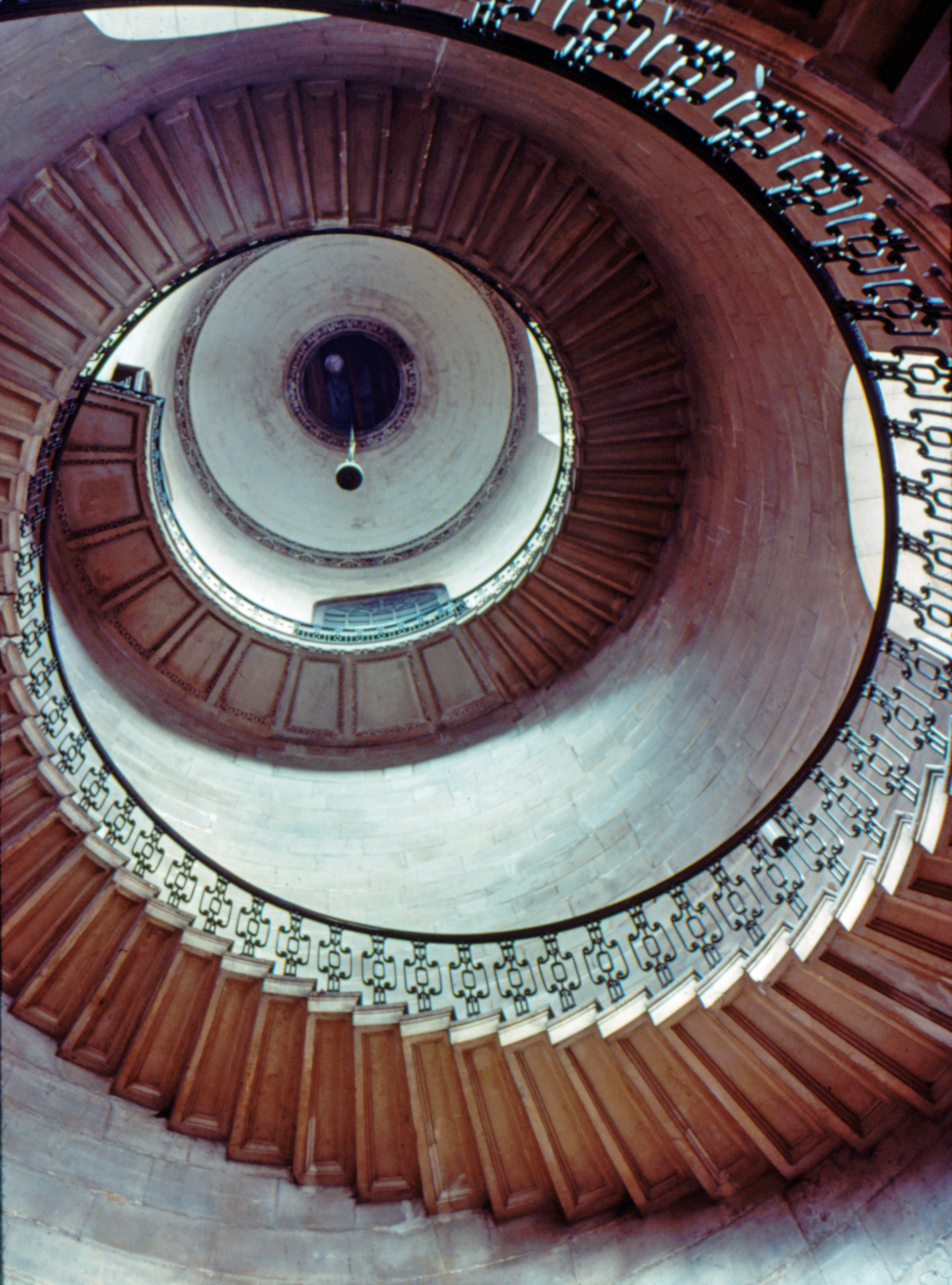 | Access to the library of St. Pauls is from the South Tower, approached by a magnificent helixical staircase. Each step is cantilevered from the sides of the tower. This staircase, which was called the "Geometrical Staircase" has an exquisite wrought iron balustrade by Tijou. The floor and other decorative stonework was carried out by Wren's best Master Mason, William Kempster. It does not go as far up as the clock - that is a more difficult climb. |
It follows that Wren was not prepared to have his masterpiece stairwell, disfigured by large clock weights swinging on heavy rope lines, or to have the inlaid marble floor at the bottom covered by some means of breaking the fall of the weights. (Such as sand). Yet there are no built in weight shafts in the South Tower.
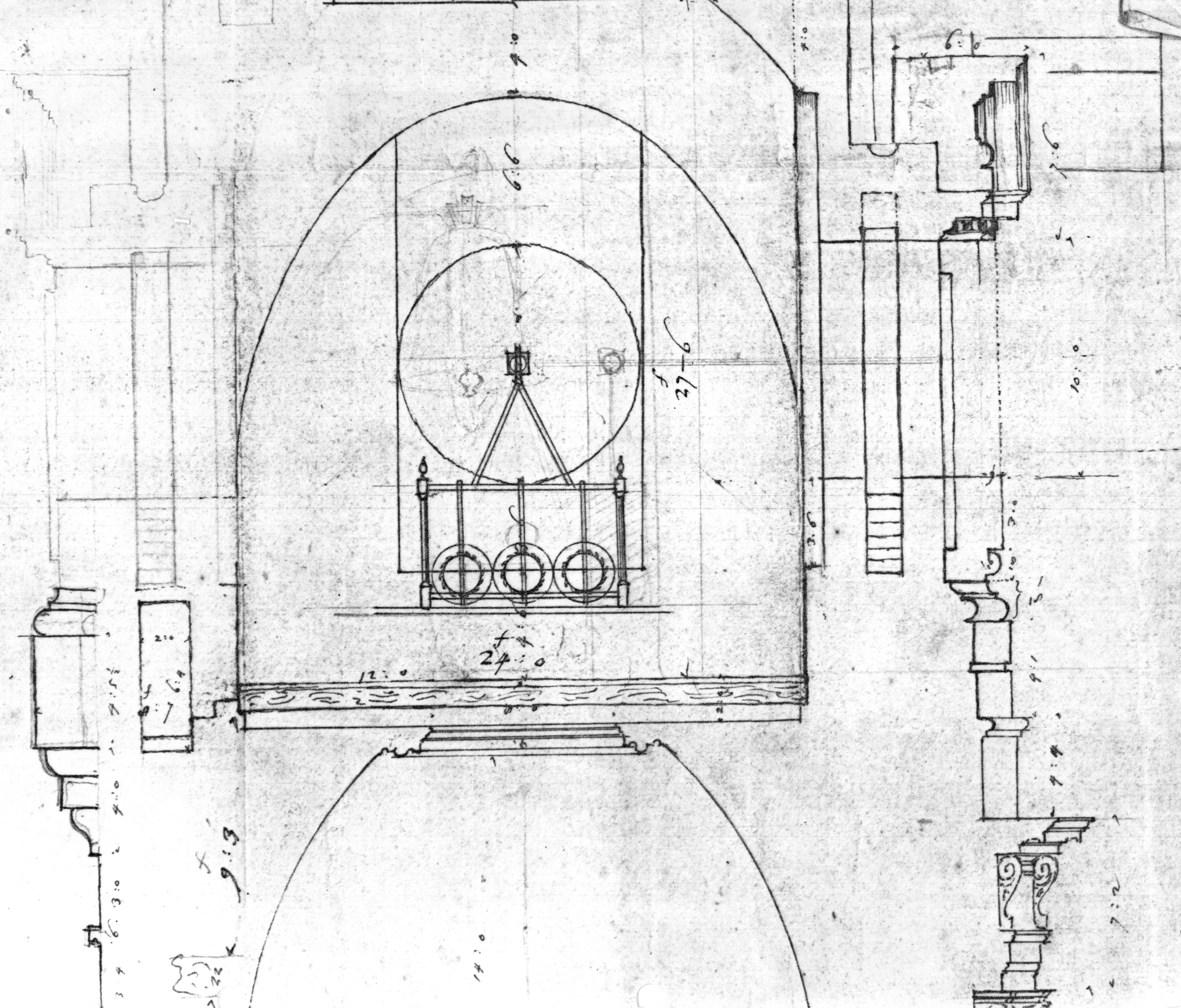 Early drawings by Wren show provision for weight shafts and contemporary accounts explain their absence by the masons ignoring or forgetting Wren's orders. However, two shafts still exist in the North Tower. In this drawing (Bute MSS) the hour bell of Langley Bradley's clock is behind the clock work.
Early drawings by Wren show provision for weight shafts and contemporary accounts explain their absence by the masons ignoring or forgetting Wren's orders. However, two shafts still exist in the North Tower. In this drawing (Bute MSS) the hour bell of Langley Bradley's clock is behind the clock work.
The decision not to have weight shafts may have been influenced by the choice of an eight-day clock striking both hours and quarters. This required three driving weights, and three separate shafts were out of the question, space being also limited by the requirements of the cantilevered staircase.
It was decided, therefore, to hang the weights above the clock. This was one of the factors that was to contribute to the failure of Langley Bradley's clock.
In 1700, the newpapers reported that Tompion was to make the new clock for St. Paul's cathedral. Tompion who was elderly by then, had no interest in taking on such work. Wren had approached Langley Bradley of Fenchurch Street, a clockmaker with a good reputation for the quality of his turret clocks, and who already possessed a workshop equipped with the necessary tools for the construction of such a large clock that Wren needed for St. Pauls.
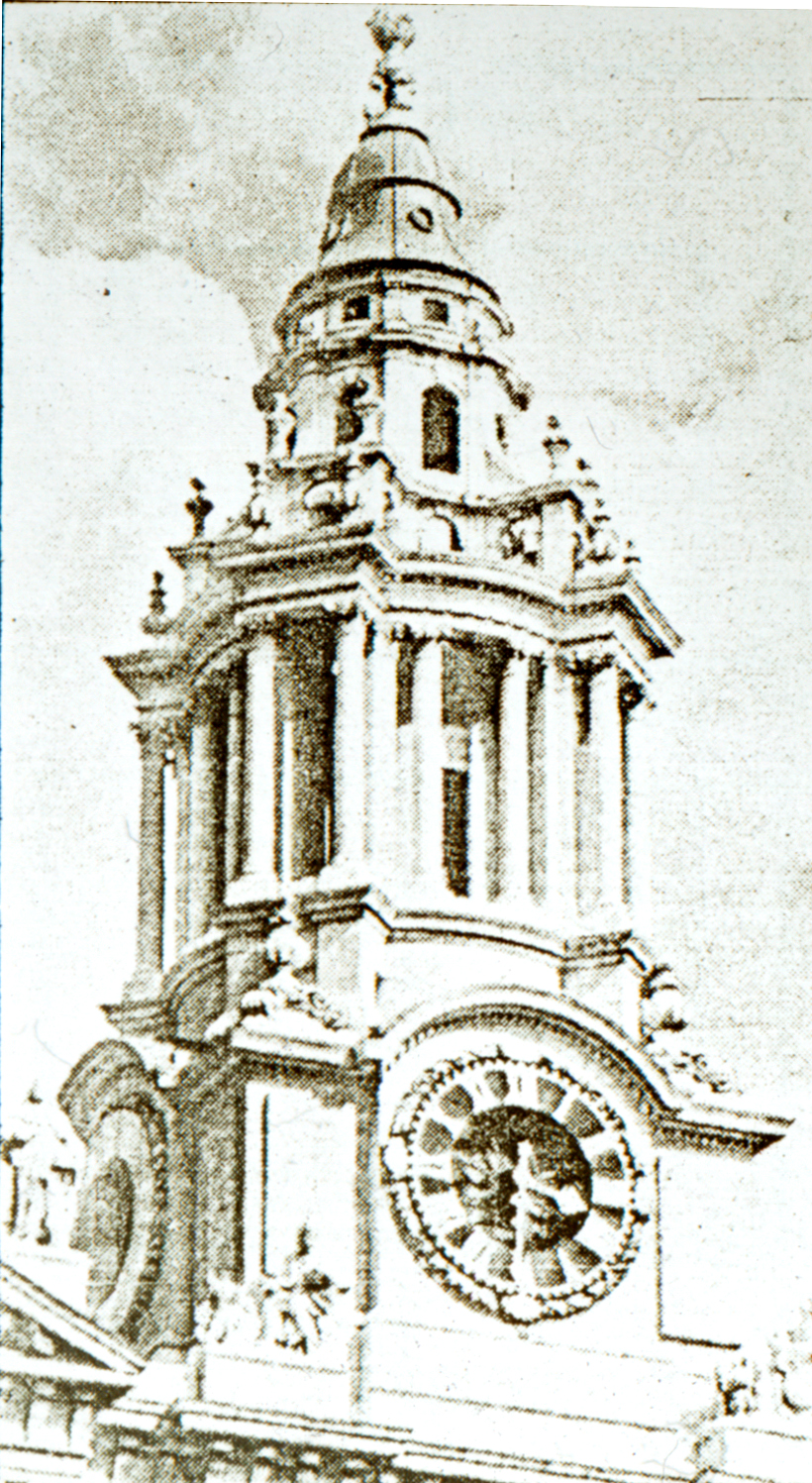
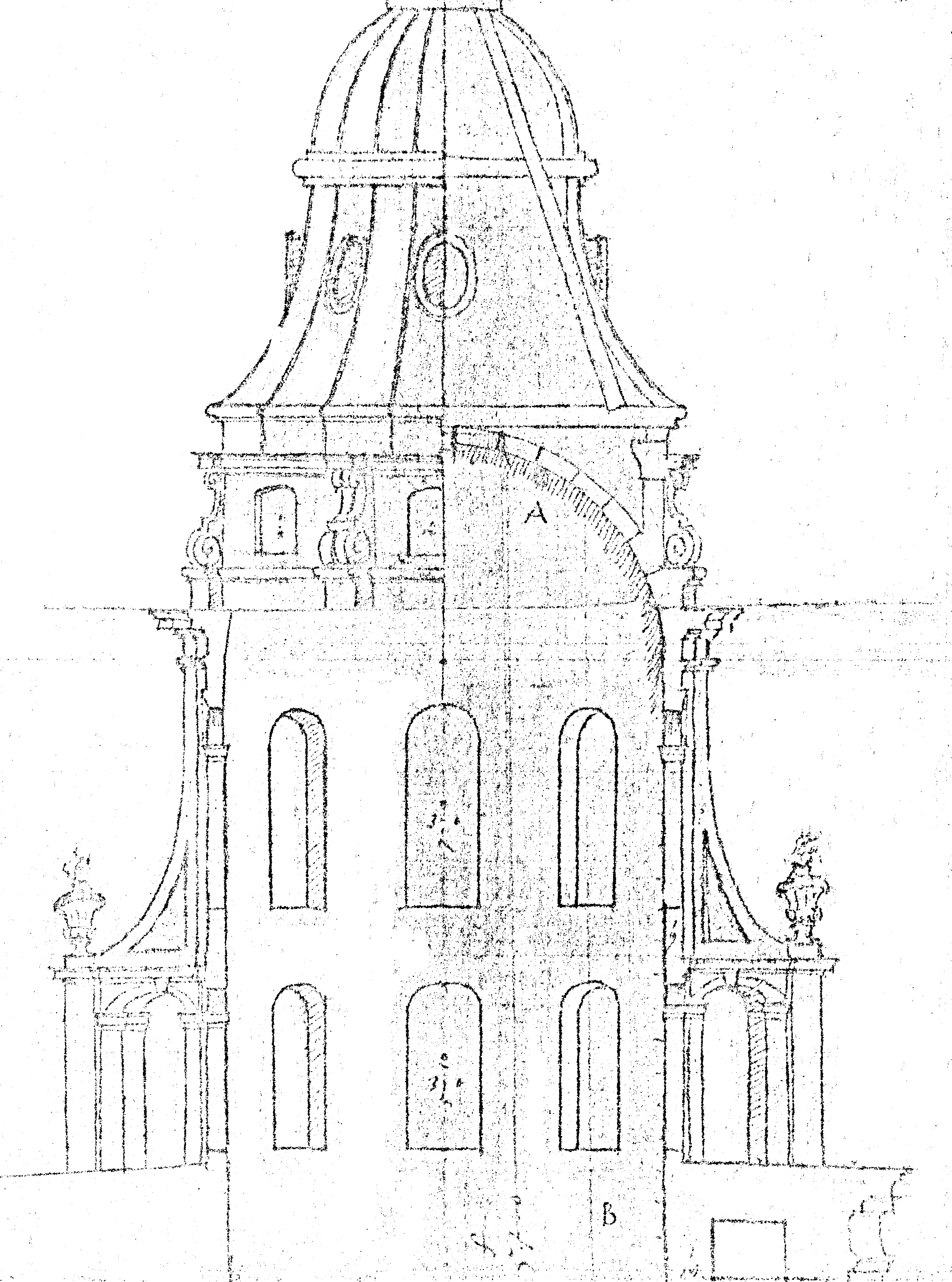 The towers are built as a series of concentric domes. Between the inner and outer domes run narrow stairways and passages giving access to the clock faces and clockroom. The dials consist of circular openings in the stonework on all four sides of the tower, repeated for symmetry in the North Tower. Only three were intended for use as dials, the fourth being invisible from the street.
The towers are built as a series of concentric domes. Between the inner and outer domes run narrow stairways and passages giving access to the clock faces and clockroom. The dials consist of circular openings in the stonework on all four sides of the tower, repeated for symmetry in the North Tower. Only three were intended for use as dials, the fourth being invisible from the street.
The original plan, was to drive the hands by means of Cardan shafts, this would give the illustion of disembodied hands pointing on a chapter ring set into the stones surrounding the apertures. This plan was actually put into practise by Bradley and was to lead to further problems with the clock.
In 1706, a specification was issued, and a contract drawn up for Bradley detailing the requirements which Bradley had to meet.
In 1707, a new Dean, Dr. Godolphin, and a new Residentary Dean, were appointed at St. Paul's. The Residentary Dean was Dr. Francis Hare, formerly Chaplain General of Marlborough's Army. Both men were to attack Christopher Wren's management of the rebuilding project in his position as the Surveyor General. No opportunity was lost to find fault with both the new and completed work and those persons engaged by Wren to carry it out.
Wren described Langley Bradley in a letter to the Lord Chamberlain's Office in 1711, as "a very able artist, very reasonable in his prices". Wren was at that time, aiming to displace the official clockmaker, William Herbert, who had recently restored the Hampton Court clock, and give that office to Bradley. However the Lord Chamberlain's Office did not agree with this, pointing out that the Queen Anne's Clockmaker was appointed by warrant to deal with Her Majesty's clocks, and that the Office of Works was not entitled to consider that turret clocks came under their provenance, merely because they happened to be part of a building.
Since Herbert had rebuilt the Hampton Court Clock before Wren gave the task to Bradley in 1711, this may have caused the remark by Derham, who was a personal friend of Bradley, concerning the removal of part of the sidereal train, "that some ignorant workman was not otherwise able to amend the clock". Wren had also pointed out that Herbert was bankrupt. This though was not unusual for a clockmaker then who had to spend on his tools, equipment, labour etc. first, then wait to be paid later. A fact the Lord Chamberlain's Office was aware of as they pointed out "it is certain can confer no right to the works on Sir Christopher's part". (An Answer to Frauds & Abuses at St. Paul's, 1713).
In May 1711, a new Commission appointed by Parliament and packed with the Dean's friends, sacked Richard Jennings, Wren's carpenter. They appointed in his place John James, nominally as Master Carpenter, but really to supercede Wren in the management of the building.
Wren appealed to Parliament and in October, the Commission was reformed - without the Dean's friends, and with Richard Jennings re-instated as Master Carpenter.
In December 1711, although the work on the Cathedral was no way near completed, Parliament declared the Cathedral officially finished. Wren's outstanding salary was paid. But the disputes were far from over.
To defend the Dean and chapter against the charges of obstructing the Surveyor, in 1712 Dr. Hare, the Residentary Dean, published anonymously a pamphlet called "Frauds and Abuses at St. Paul's". In this he insinuated that Wren had the old Commission dissolved for fear that various fraudulent practises might come to light. Dr. Hare made accusations not only against Wren, but also against Richard Jennings the carpenter, Langley Bradley the clockmaker, and Richard Phelps the bellfounder. (Fact Against Scandal, 1713. A Continuation to Frauds & Abuses at St. Paul's 1713. The Second part of Fact Against Scandal 1713.)
On page 31 of "Frauds and Abuses" Hare states: "It may here be remark'd that most of Sir Christopher's Performances, without the Approbation of the Commssioners, have prov'd very faulty: To instance only in the Great Bell, which hath been cast once, and must be cast again; and the Clock which is perpetually out of order. Now when there were most able Bell-founders, and most skilful Clockmakers, who made application to be employ'd, that Sir Christopher should use such mean and unskilful Artificers, can proceed only from such private consideration, as every body may reasonably suspect".....
Hare went on to accuse Richard Jennings of paying his workmen less than the commssioners allowed, and pocketing the difference. Also of appropriating the materials provided for the Cathedral for private jobs.
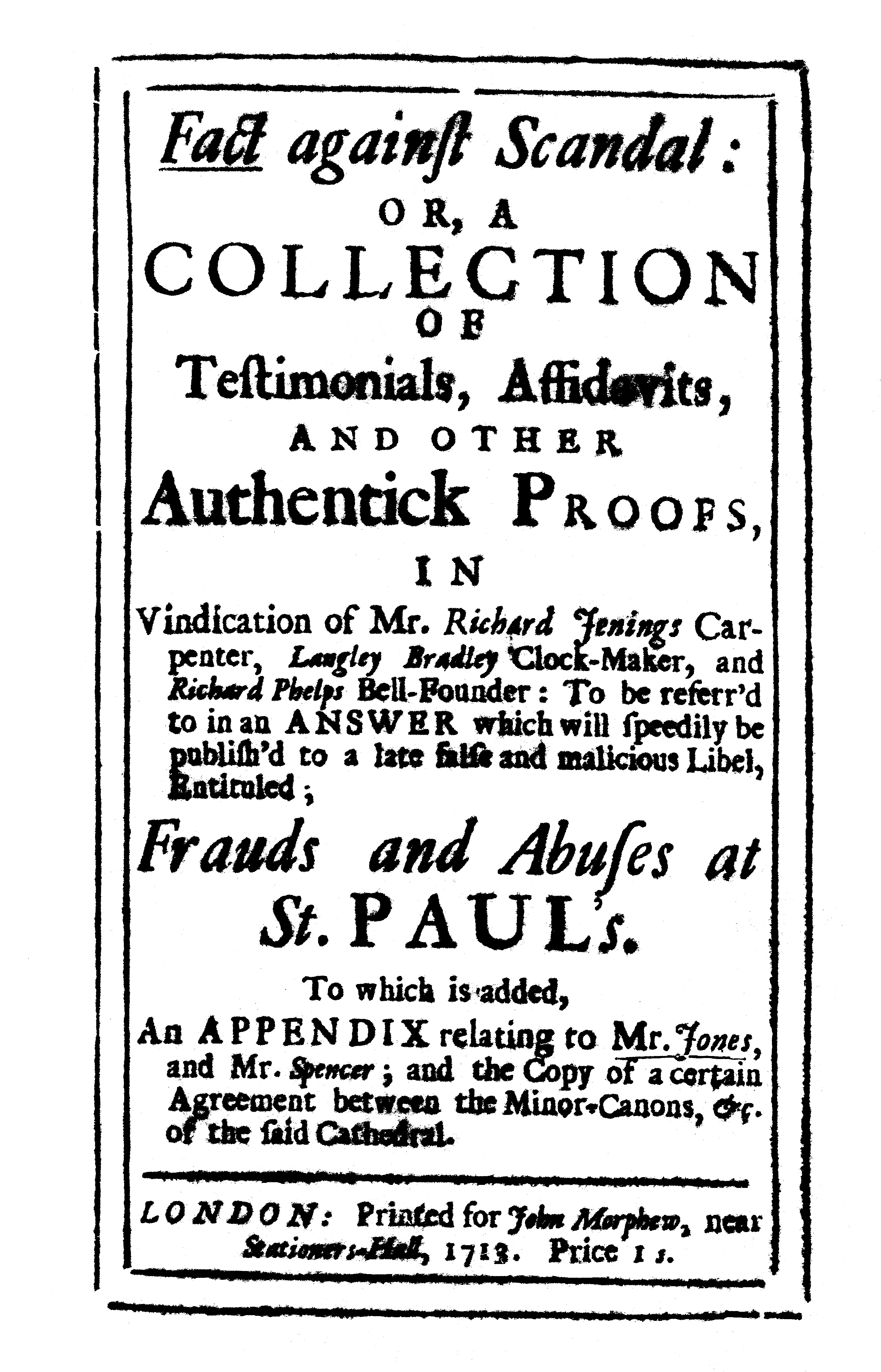 Bradley, Phelps, Jennings and Wren's other supporters published in 1713, a pamphlet in their defence, entitled "An Answer to a Pamphlet Entitled Frauds & Abuses at St. Paul's". In this they answered Hare's allegations.
Bradley, Phelps, Jennings and Wren's other supporters published in 1713, a pamphlet in their defence, entitled "An Answer to a Pamphlet Entitled Frauds & Abuses at St. Paul's". In this they answered Hare's allegations.
Phelps pointed out the "The Libeller, if he could have been the least candid, should have told the world that the Bell had already been cast twice". The original bell which had been brought from Westminster and recast by Philip Wightman, had become cracked due to the Chapter "exposing it to be made a show of and to be struck upon by those who gave money for seeing it".
The bell was then re-cast by Mr. Wightman, but the casting proved so faulty that Wren had to call in Richard Phelps of the Whitechapel foundry. Wightman died before any reparation could be made by him, therefore the new bell was cast in all new metal.
The contract with Phelps was strictly observed, the bell only being accepted after trial; when Phelps was paid and received Wightman's old bell for scrap. Phelps pointed out that he had voluntarily given his bond to the Dean and Chapter that if the bell failed within one year, he would re-cast it at his own expense. "But that time lapsing without any thing being required, that may be justly said to imply either their good Liking and Approbation of the Bel, or their gross neglect in not having it newcast, when it was so freely and fully put into their Power to have it done for nothing". (Wren Society, Vol.15 for accounts of bell and clock).
Bradley then proceeded to answer criticisms concerning the clock. He pointed out that the clock had been finished in every respect as required by the contract of 1707, and therefore any irregularity in its going was due to the practice of the Dean and Chapter of placing the clock on show to the public. He stated "he finds to his cost the ill Use that is made of his forwardness and Good Intentions in that Particular. For by the great Liberty they allow in Showing the Clock the Hands are pulled to and fro, the rods are bent; and the Movements disordered; which not only puts him to an unreasonable Trouble and Expence in rectifying those Disorders, but he is blamed fo this vey Irregularity in the Clock.....He has complained of it to the Dean, and desir'd Redress; but to no manner of Purpose". Bradley said that the original contract price for the clock included maintenance and winding for seven years.
In answer to the accusations of interest on Sir Christopher's part, the writer stated that no one else applied for the contract to cast the bell - apart from one who had the interest of the Dean - and that Sir Christopher could find no other clockmaker as well equipped a Bradley for the task. Also Bradley's prices were so reasonable that the terms were very advantageous to the church.
A Further pamphlet was published in 1713. This contained "A Vindication of Langley Bradley, clockmaker, and Richard Phelps, Bellfounder.
Langley Bradley gives a full description of he clock as completed which tallies with the orginal contract. He goes on to answer criticisms concerning the advisability of the clock to run eight days as against 30 hours. Bradley's clock was driven by weights of 3 cwt, 5 cwt, 8 cwt, for the going, sgtriking and chiming trains respectively. The charge being "that is ought to do but one Day because it was...impossible to made an Eight-day Clock turn those Hands, or srike on a Bell of that bigness, unless the Weights were each a Ton or two at the least". As we shall see, Bradley's clock probably was underpowered considering that it had to manage three outside dials of 18 ft. diameter. He repeats his accusations concerning the public display of the clock saying that any reports of going out of time were caused by those who "break the Windows, get into the Clock-Room, pull the Hands, bend the Rods, disorder the Work, and frequently strike the Hammers on the Bells; which being taken for the striking of the clock out of Time, has occasion'd Peoples saying that it is often New-setting; tho' if let alone, it would not need altering in several Months".
The Appendix to Fact Against Scandal contains an account of the conviction of Richard Jones, Ironmonger (who supplied most of the iron work for St. Paul's and had Hare's interest), with five other apprentices of felony and manslaughter in 1690 at Newgate. A carpenter's apprentice called Newey died from injuries received in a brawl; the five accused were found guilty and sentenced to be burnt in the hand. It was suggested that as the apprentice's Master had preferred the charges in this case it had "made Mr. Jones have a speight to Carpenters ever since".
The second case against Jones was that of Fraud, on 5 July 1711, at the Old Bailey. Jones was accused of altering a partially paid Bill of Debenture which showed that of £ 250 owing to him for cohorn morars supplied to the Queen's Surveyor of Ordnance, £ 100 had been paid on the 17th June 1708. Jones had erased the endorsement and had passed the Bill at its full value to one Thomas Foster, who discovered the fraud.
At his trial, Jones pleaded that the Bill was useless endorsed, that he had pressing debts, and that he had only erased the endorsement as an eperiment. Jones was not convicted and the pamphleteer wonders "wether (sic) he might not have gone on to make more such EXPERIMENTS if this had not been detected".
By now the two factions were bitterly divided, and the tone of the answering pamphlets descended to the level of personal abuse.
Hare published (again anonymously) "A continuation to Frauds and Abuses at St. Paul's". On page 44, after dealing with Jennings:
"Now for a Word to Mr. Bradley and Mr. Phelps, Persons so eminent in their Professions that till very lately, I was intirely a Stranger to their Names". He goes on to say that the "malicious and unjust reflections" complained of by them are not the result of the author's animosity but merely the findings of the duly appointed Commissioners relayed through his pen. He continues "As to the Clock, the Maker, in his Description of it, does not tell us what fault had been found with the Frame, which is made of common, raw, slight, flat Bars of Iron, by no means sufficient for so great a Work, which is the Reason of its being braced in many Places with cross pieces to supply by such Patch-Work, the Want of a due Strength".
His next attack is directed at the hands - "how easily the Wind whirls them round. So that every now and then a Hand is blown off, no less than twice within this last Month....Not that any Hands can every last or go true, while these ridiculously vast Apertures remain, in which upon every high wind there is an Hurrican".
Other complaints concerned the safety of the weights should a weight line fail, remarking that Sir Christopher's instrutions had been disregarded concerning the provision of weight shafts.
Regarding Bradley's complaints concerning the showing of the clock he continues "But if this be so, why did he never Represent this to the Commissioners, all the while the Workmen had the Shewing of it, which was above two Years. When the Shewing of it was put in other Hand, then indeed he drew a Curtain before the Clock that it might not be seen; which being complained of he represented the injury done to the clock by the shewing of it". The church then ordered the tower to be shut up, not to protect the clock, but to prevent the sightseers going out onto the leads of the roof and damaging them. On the reopening of the tower to the public it appears "they had, it seems, agreed the matter among themselves, and there was a weekly Allowance out their Profits made him for it, and so long all was well; but when this Allowance was withddrawn, the Curtain was drawn again before the Clock."
Hare then lists other reasons given by Bradley himself, for the failure of the clock, such as snow freezing on the Motion-work which was not enclosed; the floor springing up under the weight of the great bell, pinching the motion work, and stopping the clock. Another time the pendulum suspension spring broke.
Hare concludes "and a better Performance might very reasonably have been expected, either from Mr. Thompion or the company of Clockmakers, who would have been Proud of such an Occasion to shew the World a Master-Piece"...
"The Second Part of Facts Against Scandal, the insults flowing thick and fast. On page 62 "As to the clock, should it speek no more Truth than he does, there would indeed be sufficient reason for Complaint. He tells us, the Wind Whirls the Minute-Hands round. The Vertigo is certainly is his own Brains whilst he talks at this rate"...
"He says, the Frame of the Clock is made of Common, Raw, slight Bars of Iron, by no means sufficient for so great a work.....I presum (sic) we are indebted to Mr. Jones for this Reflection, because perhaps the Clock was not made of Cast-Iron". (This comment is becasue Richard Jones, whose past crimes had just been published, was the owner of the Lamberhurst Foundry in Sussex, which had contracted to supply most of the Iron Work for St. Paul's. - The sarcastic hint was not without foundation.)
With regard to the comments about the necessity for bracing "Let this Author tell us, how strong the main Beam of a Sign-Iron ought to be, to need no braces"....
He goes on to dismiss the theory that the Clockmakers Company and Thomas Thompion could have done better. Tompion he says was too old, and Langley Bradley is quite prepared to lay his work open for the judgement of the Clockmakers Company under a full survey.
He concludes: "As to the Bell, I am almost inclin'd to abide by the Libeller's Judgement, who is certainly a Great Master of Sounds, and has the Proverb on his Side:
| As the F*** thinketh, So the Bell clinketh". |
In 1715, a new commission was set up under the warrant of George I. Jones the Smith, James the Carpenter, and Thornhill the Painter, were put in control. With the Dean and his residentary they were not responsible for the finishing of the Cathedral.
Wren, now 72, was to see many more alterations to his plans. One was the addition of the balustrade edging the roof, which made the third dial of the clock invisible from the street. Wren commented: "Ladies think nothing looks well without a pretty edging!"(In Wren Society Vol.16).
On 12th April, 1716, a meeting of the Commissioners, who now included Sir Isaac Newton, was held in the new Chapter House. They came to the resolution: "That Mr. Bradley consider the objections that we made to the Clock and also what charge it will be to make the Clock go but 30 hours".
On the 3rd May, 1716, the Commissioners decided "that Mr. Bradley doe bring in a porposall in writing of the charge to make the Clock to goe but 30 hours. And that Mr. Jones doe confer with Mr. Wright, the clockmaker, concerning his Opinion of the charge of the same alteration".
On the 31st May 1716, the Commissioners further decided "That Mr. James doe conferre with Mr. Wright and Mr. Street clockmakers, to give their Opinion of the clock and concerning the alteration of it, as hath been proposed, and to bring their separate proposals of the charge thereof at the next Meeting".
On the 28th June 1716, the Commissioners decided "That Mr. Wright and Mr. Street, clockmakers doe bring in their severall proposalls in writing for the charge and manner of the altration of the Clock as hath been directed, at the next meeting of the Commissioners. And that Mr. Bradlley's proposal for the same which was this day brought in, be then considered".
William Wright of Crown Street, Southwark, and Richard Street of Fleet Street, seem to have been connected in some way with Jones the Ironmonger, who was interested in supplying the iron for a new clock.
On 9th July, 1716, the Commissioners ordered: "that Mr. Wright and Mr. Street doe consider what it will cost to turne the Clock that was made by Mr. Bradley into a thirty hour clock, and to carry three hour hands without a minute hand. And that they doe also further consider what a new Clock will cost to doe the offices before mentioned, and to be serviceable to carry the Hands thay may be required in the N.W. Tower. And that they do give in their Answer in writing to Mr. James some time within 10 days".
It seems that the Commissioners no longer intended to continue with Bradley's services. But they were still considering setting up a clock dial in the N.W. Tower, as had been mentioned in Langley Bradley's contract.
On 2nd August 1716, the Commissioners ordered: "That Mr. James doe draw up a Contract with Mr. Wright and Mr. Street, Clockmakers, to make a new Clock according to their proposal delivered in writing to the Commssioners". And on 29 August, they "Ordered that the Contract drawn by Mr. James with Mr. Wright and Mr Street, Clockmakers, which was now read, be fairly engrost upon Stampt Paper and executed accordingly".
The Commissioners next turned their atention to the large bell which had to be installed with the clock. Richard Phelps recast the bell which weighed 92 cwts 0.14 lbs. and he was paid £123 0s 0d. A frame was made to hang the Great Bell higher in the S.W. Tower.
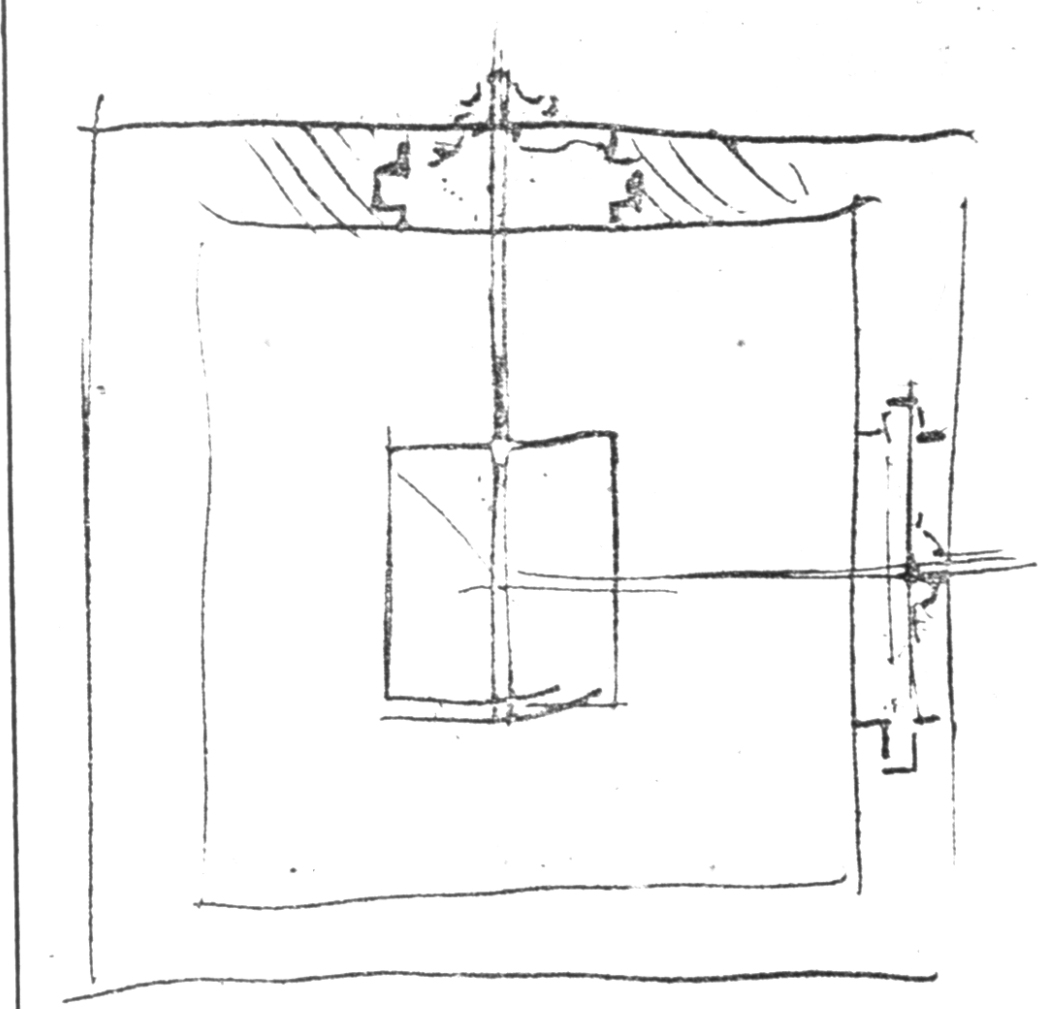 4th October 1716, Mr. James & Mr. Jones were to "inspect what proceeding have been made by Mr. Wright and Mr. Street in making the new Clock and report the same to the Commissioners before the sum of £300 be paid to them in part for the same according to contract".
4th October 1716, Mr. James & Mr. Jones were to "inspect what proceeding have been made by Mr. Wright and Mr. Street in making the new Clock and report the same to the Commissioners before the sum of £300 be paid to them in part for the same according to contract".
Richard Jones the Smith, supplied most of the iron and copper for the new clock as anticipated, for which he was paid £132. 2s. 3d. in 1718.
In February 1717, Mr. Spencer, the Paymaster of Works was ordered to pay Wright and Street £300 in part payment. The work continued slowly, and in June Wright and Street were asked to an account of their progress to Mr. James and Mr. Jones.
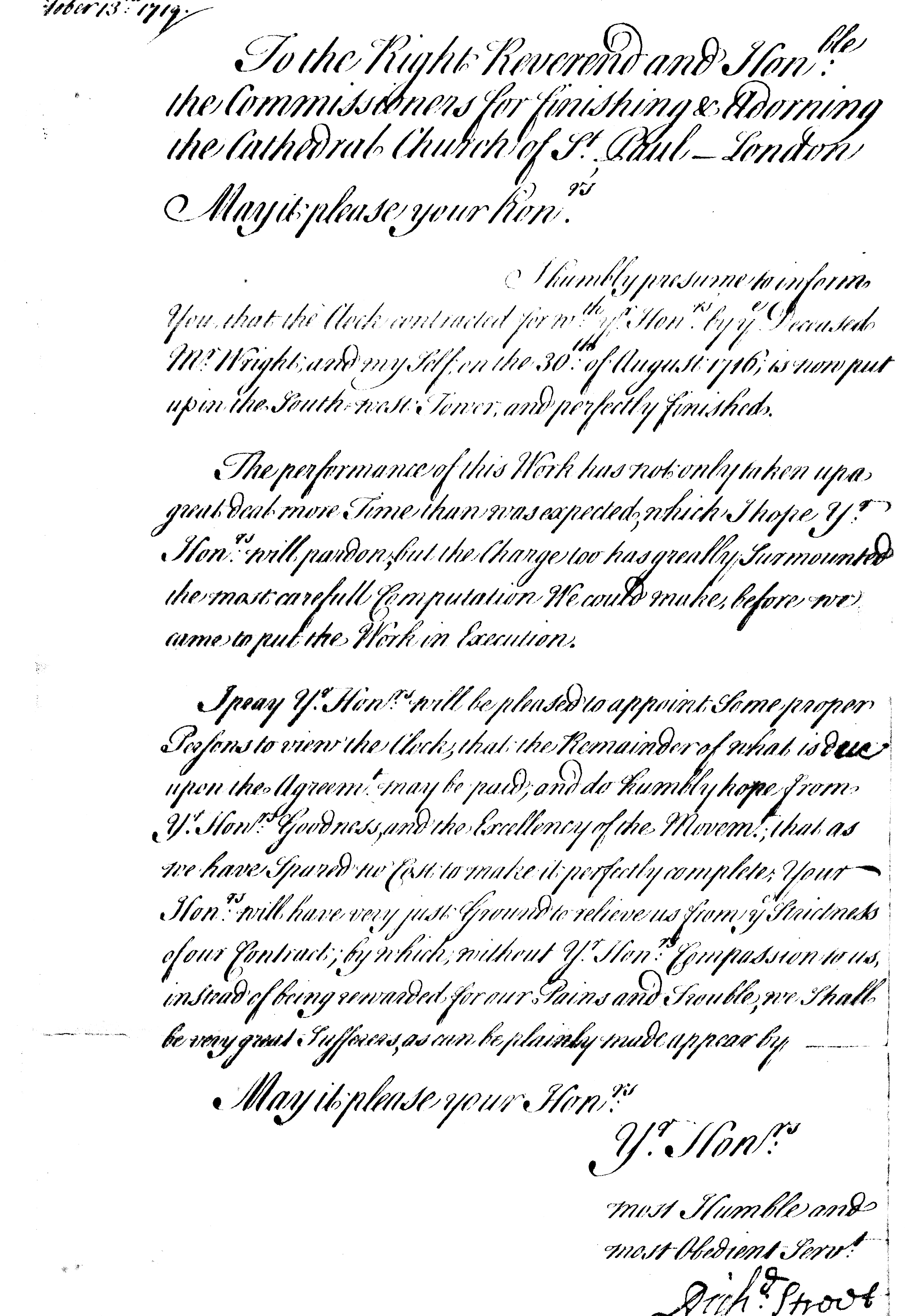 Two winters later, the Clockmakers and the Commissioners had learned what the wind from the Thames could do to a clock in such an exposed position. Richard Street wrote to the commissioners requesting a sum additional to the original contract price, because of the difficulties they had encountered. On 25th February 1719, the Commissioners "Ordered: That the round windows on S. & N.W. Sides of the S.W. Tower be filled with a middle piece of copper work to carry the hands of the Clock, and that the rest be divided into pannels for plates of Copper or the most proper metal for service and Keeping out the Weather, the filling up of which may be done with pannels of wood till further Order".
Two winters later, the Clockmakers and the Commissioners had learned what the wind from the Thames could do to a clock in such an exposed position. Richard Street wrote to the commissioners requesting a sum additional to the original contract price, because of the difficulties they had encountered. On 25th February 1719, the Commissioners "Ordered: That the round windows on S. & N.W. Sides of the S.W. Tower be filled with a middle piece of copper work to carry the hands of the Clock, and that the rest be divided into pannels for plates of Copper or the most proper metal for service and Keeping out the Weather, the filling up of which may be done with pannels of wood till further Order".
Carpenters erected scaffolding in front of the South and West dials. Benjamin Mauson, the Smith, who succeeded Jones, installed new iron and copper work to replace the slender cross pieces that had carried the ends of Bradley's shafts. This consisted for 4 cross braces forming a square in the centre to carry the motion work. Mouson provided four hands of sheet copper which cost £14 0s. 0d. and received a total of £756 0s 0d. While Wright and Street had been waiting to get paid, Wright had died. When finally it was "Ordered on 13th October, 1719, that the summe of £200, Be paid to the Clockmakers in further part for the new clock as soon as they have agreed and are ready to give proper Discharges" - they also had to ask "that Enquiry be made whether Mr. Wright's son be Executor to his father dec'd and that it be referred to Mr. James what Compensation the Clockmakers may deserve over and above their contract and that he make his Report thereof to the Commissioners at their next meeting, and that Mr. Street be obliged in his next Contract to take care of Winding up of the Clock". Street was to be paid £26 a year for winding the clock.
In 1720, Wright and Street's account was finally settled at a total of £500 plus Bradley's old clock. Street also received an extra £30 as "Reward for his Extra Care & Expedition in performing his Contract in making the Clock as per Order of the Commissioners". In the end the Commissioners had paid £500 for a thirty-hour clock when Bradley had been prepared to supply an eight-day clock for £300 including maintenance for the next 7 years.
The clock tower was restored in 1815 and a lightening conductor fitted. Wright and Street's clock functioned with the weights above - same as Bradley's (even been confused with Bradley's clock in Britten's "Old Clocks and Watches").
In 1892 The Dean of St. Paul's consulted Edmund Beckett, Lord Grimthorpe for advice on renewing the clock and its bells.
The new clock was made and installed by John Smith and Sons of Derby, under Grimthorpe's supervision. This clock was of cast-iron flat-bed construction, 19 feet long, and goes eight days. The weights were hung down the centre of Wren's Geometrical Staircase, until 1969 when it was converted to electrical auxiliary winding. This was the clock we saw.
It has a 2 second pendulum, 14 ft. long, driven by a double three-legged gravity escapement. The same as Grimsthorpe's Westminster Clock (known as Big Ben after the name of its bell). We were told it was an excellent time keeper.
Wright and Street had only used two dials, but the current clock uses three - although the third is not clearly visible from outside, The sundials once placed outside the dials to regulate the clock have been removed as no longer required for adjusting the clock to the precise time, one is in the library, the other in the churchyard. The hour hands are 5 ft 6 in. long, the minute hands 9 ft 6 in (only have the older measurements at this time). At the time we were there, the clock was still serviced by John Smith and Sons.
Grimsthorpe designed the clock to strike on a new hour bell by Taylor of Loughborough which is called "Great Paul". It is bigger than its London rival "Big Ben" being 16 tons 14 cwt which is 3 tons 3 cwt more than Big Ben.
According to Grimsthorpe (in his book Clocks, Watches & Bells) ..."objection was taken to altering the striking from the very inferior old "Phelps bell". So "Great Paul" strikes only at one o'clock midday and on special occasions.
So the clock bells by Phelps are still in use. The quarter chimes are struck on two bells weighting 12 cwt 2 qtr 9 lb and 24 cwt 2 qtr 14 lb. Both are inscribed "Richard Phelps made me 1707". The hour bell weights 4 ton 12 cwt 14 lb. and says on it "Richard Phelps made me 1716".
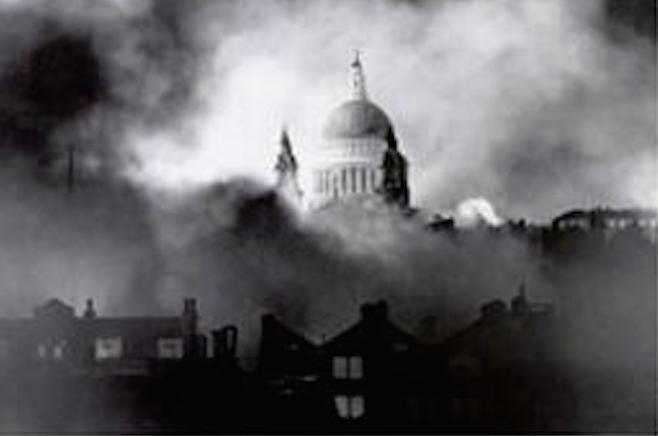 St. Pauls made a good target in the Blitz of 1940. Once again it was nearly totally destroyed by fire. So was all the surrounding area. It says much for the rebuilding after the previous fire that most of St.Paul's actually survived to be restored much as Wren had intended. The picture under the heading is of the cathedral in the 1950s. Most of the surrounding area still looked a bomb site full of weed covered ruins until the mid 1960s. And was rebuilt to look totally different. It changed even more when the printers and publishers and book shops that had characterized the area, moved further east when the docklands were rebuilt.
St. Pauls made a good target in the Blitz of 1940. Once again it was nearly totally destroyed by fire. So was all the surrounding area. It says much for the rebuilding after the previous fire that most of St.Paul's actually survived to be restored much as Wren had intended. The picture under the heading is of the cathedral in the 1950s. Most of the surrounding area still looked a bomb site full of weed covered ruins until the mid 1960s. And was rebuilt to look totally different. It changed even more when the printers and publishers and book shops that had characterized the area, moved further east when the docklands were rebuilt.
links, comments and additional information, always welcome
 |